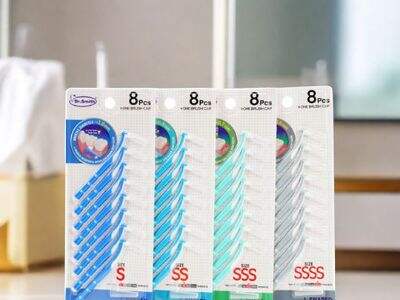Att få en rensad tandborste är också avgörande för att bibehålla hälsan och styrkan på dina tänder. En smutsig tandborste kan vara en odling av bakterier, de samma mikrober som kan göra dig sjuk eller orsaka en infektion i munnen. Följ Dr. Smiths praktiska guide för tandborstsvård för att hjälpa dig. Denna guide kommer att lära dig rengöringsprocessen för att säkerställa att din tandborste är fri från patogener och säker att använda.
Håll Din Tandborste Rent: En Guide
Du bör byta tandborste var tredje till fjärde månaden. I Vattenflösningsvitning andra ord, du bör byta ut din tandborste ungefär var fjärde månad. Borrstenarna -- de små, mjuka delarna av tandborsten -- blir slitas ut och rivna och rengör inte dina tänder bra längre. En sliten tandborste kanske inte kan ta bort plak och mikrober från dina tänder och köttben effektivt. Här är vad du kan göra för att se till att din tandborste förblir ren och säker mellan dina byte.
Enkla Rensningsråd
Du måste spola din tandborste under rinnande vatten direkt efter att du har burkat tänder. Detta Tandborste med flerfunktion ett litet extra steg sköljer bort eventuell kvarvarande tandkräm eller matpartiklar som är fastna i borsten. ”Se till att lagra din tandborste i en lodrät ställning också, som att stå rak upp i en hällare så att den kan torka ordentligt.” När du lagrar din tandborste i en stängd behållare, till exempel, kan du skapa en mörk, fuktig, fuktig mikromiljö, ett verkligt odlingssköte för bakterier.
En annan möjlighet är att desinficera din tandborste. Det är enkelt nog att göra genom att doppa din tandborste i en lösning av en del blek till 10 delar vatten. Låt den doppas i lösningen i cirka 5 till 10 minuter. Efter dopparingen se till att spola din tandborste grundligt med rent vatten innan du använder den igen. På detta sätt kommer du att vara säker på att den är säker att använda.
Varför du bör ta hand om din tandborste
Att ta hand om tandborsten på rätt sätt är därmed extremt viktigt för din totala hälsa. En använd tandborste kan växa bakterier som kan orsaka infektioner... Om din tandborste är gammal och sliten, kommer den heller inte att ta bort plack och rester lika effektivt från dina tänder och köttben. Det Borstaa på tungan utan att kväljas betyder att du möjligen inte tar bort allt plack och de bakterier som kan leda till karies och andra tandproblem.
Dessa gör-och-ikke-gör-regler för tandborstvård kommer att hjälpa dig att använda en säker tandborste. Att förstå dessa riktlinjer är nyckeln till att bibehålla din munhälsa.
Gör och Ikke-gör vid Tandborstvård
Gör:
Byt ut din tandborste var tredje till fjärde månad eller tidigare om borsten börjar se sliten och trasig ut.
Strax efter att du har använt den, spola din tandborste under rinnande vatten för att skölja bort tandkräm och bakterier.
Bevara din tandborste Uprätt så att den kan torka fullständigt. Detta hjälper till att hålla den ren.
Hälska din tandborste i en del blek till 10 delar vatten i 5–10 minuter för att desinficera den (döda germerna).
Gör inte:
Och ännu bättre, dela inte din tandborste med någon annan, eftersom den kan överföra germencer till andra personer.
Försök inte att lagra din tandborste i en stängd behållare eller kap, eftersom detta skapar en fuktig miljö där germerna kan frodas.
Rensa inte din tandborste med het vatten eller i diskmaskin, eftersom detta kan skada de mjuka borsten och göra dem mindre effektiva.
Slutligen, se till att du inte använder en gammal, sliten tandborste. På samma sätt som bra tandkräm och en ny tandborste, men någon kommer att behöva nån att borsta sina tänder, och inte alls om borstarna är trasiga, det kommer inte att rena tänderna ordentligt.
Nödvändiga underhållshabiter för tandborste
Utöver dos och icke-dos av tandborstvård, dessa är de tandvårdshabiter som alla bör praktisera för god munhygiene:
När du borstar tänderna, använd fluor-tandpaste, två gånger om dagen. Kom ihåg att borsta i två minuter varje gång för att säkerställa att alla områden är rena.
Rengör mellan dina tänder dagligen med tandtråd eller en mellantandsrenare. Detta hjälper till att lossa all matrest och plak som kan fastna mellan dina tänder.
Använd muntvätt för att döda bakterier i munnen regelbundet och för att hålla andedräkten frisk. Muntvätt kan också nå de platser som tandborstning kanske missar.
Du får en professionell rengöring på din tandläkarpraxis när du går dit för kontroll regelbundet. Din tandläkare kan se till att dina tänder och köttlor är i god skick och ge råd om hur du ska vårdta dem.
Så är det extremt viktigt att ta hand om din tandborste för din munhälsa. Att följa doktor Smiths guide för tandborstsvård säkerställer att din tandborste förblir ren och fri från bakterier. Och kom ihåg att byta ut din tandborste var tredje till fjärde månad, spola den under rinnande vatten efter användning och lagra den uppstött för att lufttorkas. Genom att praktisera dessa små saker kan du hålla ditt leende klart och friskt i åratal!
 En
En
 AR
AR
 BG
BG
 CS
CS
 DA
DA
 NL
NL
 FR
FR
 DE
DE
 EL
EL
 HI
HI
 IT
IT
 JA
JA
 KO
KO
 PL
PL
 PT
PT
 RU
RU
 ES
ES
 SV
SV
 TL
TL
 IW
IW
 ID
ID
 UK
UK
 VI
VI
 HU
HU
 TH
TH
 TR
TR
 FA
FA
 MS
MS
 GA
GA
 BE
BE
 AZ
AZ
 KA
KA
 BN
BN
 LA
LA
 NE
NE
 MY
MY
 KK
KK
 TG
TG
 UZ
UZ
 KY
KY

